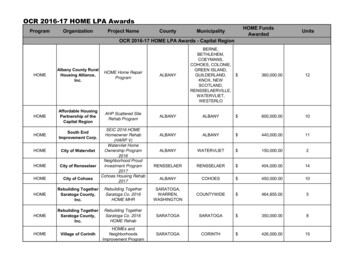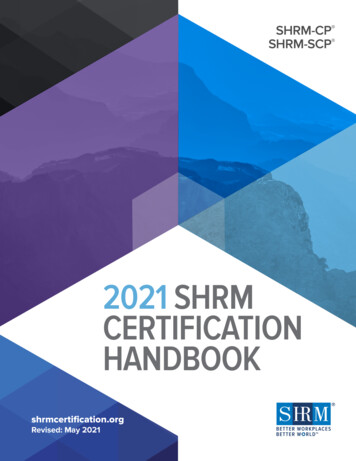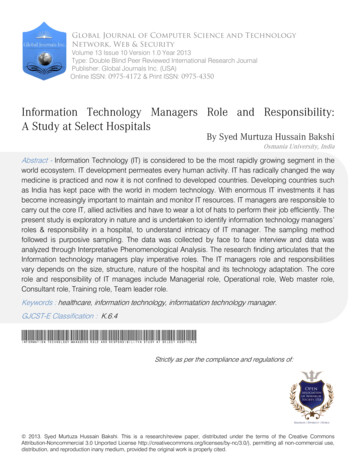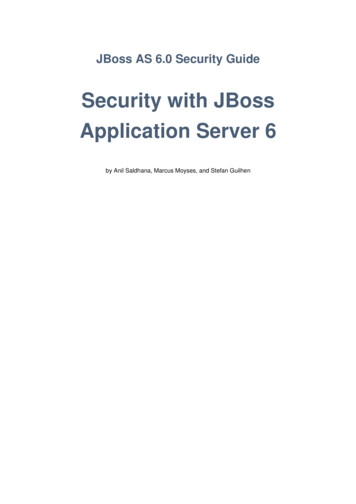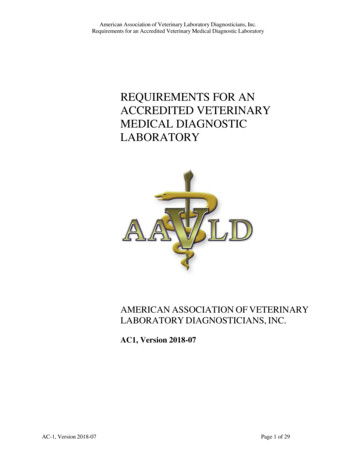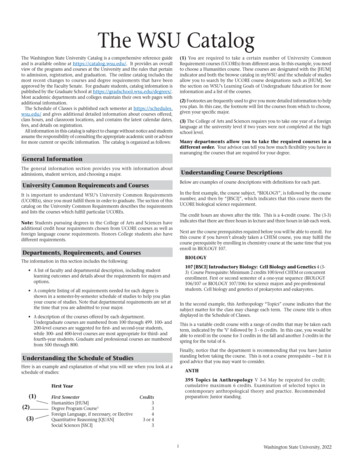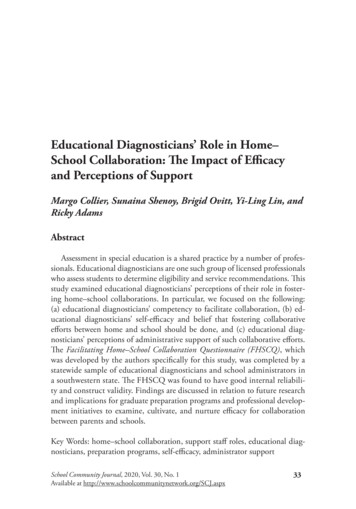
Transcription
Educational Diagnosticians’ Role in Home–School Collaboration: The Impact of Efficacyand Perceptions of SupportMargo Collier, Sunaina Shenoy, Brigid Ovitt, Yi-Ling Lin, andRicky AdamsAbstractAssessment in special education is a shared practice by a number of professionals. Educational diagnosticians are one such group of licensed professionalswho assess students to determine eligibility and service recommendations. Thisstudy examined educational diagnosticians’ perceptions of their role in fostering home–school collaborations. In particular, we focused on the following:(a) educational diagnosticians’ competency to facilitate collaboration, (b) educational diagnosticians’ self-efficacy and belief that fostering collaborativeefforts between home and school should be done, and (c) educational diagnosticians’ perceptions of administrative support of such collaborative efforts.The Facilitating Home–School Collaboration Questionnaire (FHSCQ), whichwas developed by the authors specifically for this study, was completed by astatewide sample of educational diagnosticians and school administrators ina southwestern state. The FHSCQ was found to have good internal reliability and construct validity. Findings are discussed in relation to future researchand implications for graduate preparation programs and professional development initiatives to examine, cultivate, and nurture efficacy for collaborationbetween parents and schools.Key Words: home–school collaboration, support staff roles, educational diagnosticians, preparation programs, self-efficacy, administrator supportSchool Community Journal, 2020, Vol. 30, No. 1Available at http://www.schoolcommunitynetwork.org/SCJ.aspx33
SCHOOL COMMUNITY JOURNALIntroductionExtensive research has established the link between home–school collaboration and student success. Parents’ involvement in their children’s educationincreases student academic achievement and overall success (Epstein, 2005;Epstein & Sanders, 2009; Flores de Apodaca et al., 2015; Henderson & Mapp,2002; Jeynes, 2005; Pomerantz et al., 2007; Zhang et al., 2011). Positive relationships between schools and parents have been vital in providing effectiveeducational services and support for children with disabilities (Colarusso &O’Rourke, 2007; Gross et al., 2015). Forming positive relationships is mutually beneficial for parents, students, and professionals. Unfortunately, thelevel of collaboration between parents and educational professionals is less thanoptimal (Dunst & Dempsey, 2007; Forlin & Hopewell, 2006). This article examines the role of educational diagnosticians by measuring their perceptions ofself-efficacy and administrative support for facilitating home–school collaboration. It should be noted that throughout this paper, the term “parent” is usedto refer to any adult caregiver who might interact with the diagnosticians onbehalf of the student.The U.S. federal government has repeatedly affirmed the positive effect ofparental involvement in the education of children with and without disabilities as evidenced by federal mandates such as the most recent revision of theIndividuals with Disabilities Education Act (IDEA, 2004) and the Every Student Succeeds Act (ESSA, 2015). Schools, districts, and states are required toensure that schools provide parents with tools to participate in their children’seducation and that they actively seek out, welcome, and respond to parents’ involvement, especially parents of students who receive special education services.Although educators recognize the need for home–school collaborative relationships, establishing collaboration can be difficult (Epstein, 2005; Forlin et al.,2006; Murray et al., 2008). Teachers, in particular, are in a prime position todevelop productive collaborative relationships with parents; however, they frequently feel that they do not possess the necessary skills to do so successfully.IDEA also stipulates that students with disabilities receive special educationservices in the least restrictive environment (Cartledge, 2006). General educators are now expected to deliver instruction to students with disabilities withingeneral education classes. Students with disabilities may require culturally responsive instruction, differentiated instruction, application of universal designof instruction, and positive behavioral supports (Heward, 2013; Morningstaret al., 2015; Office of Special Education and Rehabilitative Services [OSERS],2015). However, Friend (2011) noted that many general educators are ill prepared to provide inclusive general education for students with disabilities in34
DIAGNOSTICIANS AND COLLABORATIONtheir classes without support services such as special education teachers, educational diagnosticians, school psychologists, speech-language pathologists,social workers, and school counselors.Roles of Support ProfessionalsLegal mandates have promoted interdependency among a variety of support professionals. Within inclusive settings, special educators are trained tomeet the needs of students with disabilities, implement educational strategies, and ensure that accommodations are executed in the general educationclassroom. Speech-language pathologists often help children with disabilitiesdevelop communication skills (American Speech-Language-Hearing Association, 2008). School counselors have expertise in career and transition planning,social skills instruction, and group dynamics (Costner & Haltiwanger, 2004).School psychologists and school counselors have been identified as the initialand primary mental health service providers for many students (Zambranoet al., 2006). Additionally, school psychologists conduct assessments, designbehavioral interventions, provide consultation regarding social–emotional issues, and implement and evaluate services and schoolwide programs (Meyers etal., 2004; NASP, 2010). Educational diagnosticians, a lesser known professionof licensed assessment specialists, also assess student’s intelligence, academicperformance, behavior and socialization, and link assessment to instruction(NCPSE, 2000).The Unique Role of the Educational DiagnosticianEducational diagnosticians typically have a background as a general or special education teacher or other education-related licensed profession and havecompleted a graduate-level certificate program of study prior to becoming alicensed assessment specialist. Educational diagnosticians play a central rolein the evaluation and assessment for determining student eligibility for specialeducation services. With their classroom experience, they are in a unique position to assess students. They assist in the educational planning, appropriateinstruction, and implementation of special education support services in theclassroom. They also help to ensure compliance with IDEA rules, regulations,and procedural requirements (Guerra & Maxwell, 2015).Given their teaching background, the National Clearinghouse for Professionals in Special Education (2000) indicated that educational diagnosticiansare skilled to help the general education teachers understand implicationsof disabilities as they pertain to the classroom as well as assist in the development of appropriate programming in the classroom. Teaching experience“adds a dimension to the interpretation of assessment results and subsequent35
SCHOOL COMMUNITY JOURNALcommunication with teachers and parents not provided by other assessmentprofessionals” (Sutton et al., 2009, p. 2). Educational diagnosticians are also ina unique position to facilitate collaboration and make assessment results relevant and meaningful for parents, teachers, and other professionals.Educational diagnosticians are typically required to have a minimum ofthree years of classroom experience and a Master’s degree in special educationor other closely related field of study. The position of the educational diagnostician is one that is less recognized than that of school psychologists. Unlikeschool psychologists who are nationally certified, educational diagnosticiansare state licensed. As of 2019, training is provided in only three states: NewMexico, Louisiana, and Texas. Nonetheless, educational diagnosticians are nowemployed in a growing number of states.The ongoing critical shortage of school psychologists (Clopton & Haselhuhn, 2009) has compounded the need for more educational diagnosticiansto determine the eligibility of students suspected of needing special services.Caranikas-Walker et al. (2006) noted a critical shortage of educational diagnosticians. Over a decade later, a shortage still exists.Home–School CollaborationThe term collaboration appears frequently in educational literature and hasvaried definitions. In the context of working with students with disabilities andtheir parents, collaboration is a process characterized by participation, shareddecision making, mutually agreed upon goals and objectives, and is a key factorin fostering positive outcomes (Friend & Cook, 2003).For years, research has confirmed the benefits of collaborative relationships between schools and parents, particularly those with students in specialeducation (Dallmer, 2004; Forlin et al., 2006; Gross et al., 2015). In addition to providing support services for students with disabilities, collaborationwith other educational professionals may facilitate the development of productive collaborative relationships between parents and teachers. Educationaldiagnosticians are frequently in a position to promote collaboration and makeassessment results relevant and meaningful for parents, teachers, and other professionals. In order to forge relationships, educational diagnosticians need tocreate opportunities for parents and teachers to listen to one another and together devise an effective educational program for the student. Prior to theIndividualized Educational Program (IEP) meeting, at which an exchange ofideas among parents, teachers, and other professionals is typically shared, theeducational diagnostician can arrange to meet with the parents. Such a meetingcan include the assistance of a translator if needed. A preliminary meeting allows the educational diagnostician time with parents to discuss their concerns,36
DIAGNOSTICIANS AND COLLABORATIONclarify findings related to assessment results, and answer questions that parentsmay wish to ask. Parents are thus provided the opportunity to process information in a less stressful setting and as a result may feel less overwhelmed orless intimidated at the IEP meeting. Initiating such practices can reinforce theeducational diagnostician’s collaborative role as unifying or orchestrating rather than exclusively leading the Eligibility Determination Team (EDT) meetingor, in some cases, the Individualized Education Plan (IEP) meeting.Self-EfficacyBandura defines self-efficacy as the belief in one’s capacity to accomplishtasks and achieve desired goals (1986) and, further, suggests that an individual’s personal perception of efficacy is significant when making decisions relatedto their desired goals and the effort and persistence they are willing to put forthto achieve those goals (1977). The stronger a person’s efficacy, the more effortthey will exert. Educators with high self-efficacy are more likely to achievesuccessful outcomes when they initiate collaborative efforts with parents andto persist when faced with initial parental resistance than educators with lessself-efficacy.In addition to having skills, knowledge, and competency, educational diagnosticians need to perceive themselves as being capable in these settings. Uponreflection, the researchers of this study decided to further break apart the concept of self-efficacy into two elements—beliefs and competency. By separatingout the element of efficacy, we can then focus on an educational diagnostician’sbeliefs or values when it comes to fostering productive relationships betweenhome and school. Thus, effective collaboration should be central to a diagnostician’s responsibilities. Educational diagnosticians’ self-efficacy incorporatesboth the competency to collaborate with teachers and parents in the interest ofstudents and the belief that this should be done. Another factor that influenceseducational diagnosticians’ success in collaboration is their perceptions of administrative support.Administrative SupportThe school environment affects the extent to which educational professionals seek out and work to strengthen relationships with students’ parents (Manzet al., 2009; Moolenaar et al., 2012; Sanders & Harvey, 2002; Smith et al.,1997). In a large-scale study, Seitsinger et al. (2008) found that the more educational professionals reached out to parents, the more likely parents were tomake reciprocal efforts to engage with the school. Studies conducted by Griffith (1991) and Krumm and Curry (2017) found that school principals werecritical in creating, building, and sustaining positive school environments.37
SCHOOL COMMUNITY JOURNALStrickland-Cohen et al. (2014) found that administrators play a significantrole in the implementation and sustainability of practices that impact studentswith disabilities. Research has indicated that school professionals who receivesupport from their administrators engaged significantly more in actual collaboration (Krumm & Curry, 2017; Pang & Watson, 2000; Staton & Gilligan,2003; Wade et al.,1994).Purpose of the StudyThe purpose of our study was to examine educational diagnosticians’ attitudes, beliefs, and perceptions toward their role in fostering home–schoolcollaboration, their competency to accomplish facilitating collaboration, administrators’ support of such collaborative efforts, and educational diagnosticians’perceptions of that support. Our conception of home–school collaborationdraws on Epstein’s concept of parent involvement, which encompasses parentcommunication with children about education, parent participation in schooldecision making, parental engagement with schools and teachers, and parentcollaboration with the school community (Epstein, 1995). We use Christenson’s and Cleary’s (1990) definition of home–school collaboration as “addressingparents’ and teachers’ concerns about children, engaging in problem solvingwith parents and teachers to resolve educational problems, and establishinga partnership based on mutual respect, an understanding of the roles and responsibilities of home and school, and shared decision making” (p. 226).MethodThis study employed both survey design and structured, open-ended interviews to explore educational diagnosticians’ perceptions of what their rolein facilitating home–school collaboration should be and to determine the frequency of their participation in facilitating home–school collaboration.InstrumentationIn order to measure how educational diagnosticians’ perceived self-efficacy,competency, and administrative support for their collaboration with parentsinfluences their practice, a questionnaire was developed entitled The Role ofEducational Diagnosticians: Facilitating Home–School Collaboration Questionnaire (FHSCQ). Prior research conducted by Epstein (2005) and Mellon andWinton (2003) provided a foundation. Additionally, items incorporated intothe questionnaire were constructed to reflect some of the skills and knowledgerelated to the concept of collaboration as stated within the Special EducationAdvanced Roles Content Standards (ARCS) developed by National Certification of Educational Diagnosticians Board (NCED, 2012).38
DIAGNOSTICIANS AND COLLABORATIONThe instrument was initially reviewed by a panel of five educational professionals, including a special education director, director of a parent advocacyprogram, and three educational diagnosticians. The questionnaire was adjusted based on the panel’s feedback. The questionnaire was then field-tested by12 educational diagnosticians, providing information used to refine the questionnaire. The resulting FHSCQ contained 24 items to evaluate educationaldiagnosticians’ perceptions of their self-efficacy, competency, and administrative support for collaboration with parents. Using a 4-point Likert scale,participants indicated their agreement with items related to their perceptionsof facilitating collaboration with parents and teachers, increasing communication, encouraging participation in decision-making practices, providinginformation related to the child’s learning, and clarifying assessment results asthey relate to interventions (see Appendix A).An abbreviated version of the questionnaire, The Role of Administration:Supporting Practices of Home–School Collaboration Questionnaire (SPHSCQ),was also developed to rate lead administrators’ perceptions of the support thatthey provided to educational diagnosticians related to home–school collaboration (see Appendix B). The SPHSCQ contains 18 items, many of which wereconstructed to align with the FHSCQ. The FHSCQ and the SPHSCQ eachcontain a section to obtain information on participants’ demographics, employment background, and current practices. The FHSCQ and the SPHSCQwere recreated as online questionnaires and distributed via SurveyMonkey.ProcedureWith the approval of each superintendent, we invited educational diagnosticians and special education directors/administrators from all 89 public schooldistricts across the state of New Mexico to participate in this study. Each superintendent received an email containing a description of the study and onlineconsent forms and questionnaires, as well as access to pass them on to professionals in their district.The authors used an online questionnaire as well as follow-up interviewsconducted over the phone to collect the data. We designed a structured set ofquestions to use for the phone interviews. We coded educational diagnosticians’ phone interview responses using interviewer notation. Sample responsesof participants who engaged in the phone interviews can be viewed in Appendix C. Participants were not offered an incentive for participating in either theonline questionnaire or the phone interviews.ParticipantsEmails requesting participation and providing electronic links to accessthe online surveys were sent to the superintendents of each school district.39
SCHOOL COMMUNITY JOURNALAlthough incumbent upon the superintendents to provide access to educational diagnosticians and special education administrators within their schooldistrict, not all superintendents followed through in providing access. Of thoseprofessionals who received access, 49% (n 116) of educational diagnosticiansand 51% (n 45) of special education administrators completed the questionnaires. The number of participants was further reduced by the exclusion ofthose whose questionnaires were incomplete or those who failed to consent.The response rate was 26% of licensed statewide educational diagnosticians (n 61) and 28% of the lead special education administrators (n 25) throughout the state who received access to and completed the questionnaires. Themajority of both educational diagnosticians and administrators respondingwas female, 62% and 40%, respectively. Although 33% of the educational diagnosticians and 52% of administrators failed to identify their ethnicity, themajority of those who reported their ethnicity for both groups was Caucasian(n 23 and n 7, respectively), followed by Hispanic (n 12 and n 4, respectively, see Table 1).Phone InterviewsFifty-one educational diagnosticians who had participated in taking the online questionnaire indicated that they were also willing to be interviewed. Astratified purposive sampling strategy (Creswell, 2008; Miles & Huberman,1994) was used to select 12 participants from those who had indicated interest in being interviewed based on the type (urban or rural) and size of schooldistricts. The participants interviewed included six educational diagnosticiansemployed at urban schools and six at rural schools.Data AnalysisDescriptive statistics were employed for all demographic variables. In orderto examine the structure of the FHSCQ, we conducted a factor analysis todetermine construct validity and calculated the Cronbach’s alpha reliabilitycoefficients to determine the internal consistency.We conducted an independent samples t-test to compare educational diagnosticians’ perceptions with those of their administrators. We used regressionanalyses to ascertain the relationship between the independent variable, the educational diagnostician’s current practices of collaboration, and the dependentvariables: efficacy, competency, and perceived administrative support.40
DIAGNOSTICIANS AND COLLABORATIONTable 1. eFemaleNot reportedEthnicityCaucasianHispanicNative AmericanAfrican AmericanAsianOtherNot reportedYears administering/assessing0–5 years6–10 years11–15 years16–20 years21–25 yearsmore than 25 yearsNot reportedAdministratorn 25%Educational Diagnosticiann 12773362319.711.511.54.94.99.837.7ResultsThe primary purpose of this study was to examine educational diagnosticians’ perceptions of their role in fostering home–school collaborations.Findings from this study are reviewed in this section.Construct Validity and Internal ConsistencyIn order to examine the construct validity of the FHSCQ, a promax rotation factor analysis was undertaken. The factor analysis of responses produceda four-factor solution accounting for 65.46% of the variance. The overall alpha coefficient was .916. Each of the four broad categories of items (currentpractices of collaboration, efficacy, competency, and perceived administrativesupport) ranged from 0.748–0.851, indicating acceptable internal consistencyof the FHSCQ (see Table 2).41
SCHOOL COMMUNITY JOURNALTable 2. Internal ConsistencyReliability Statistics (Cronbach’s Alpha)Self-Efficacy0.748Current Practices0.851Perceived Administrator Support0.778Competency0.81Overall0.916N of Items666624Comparison of PerceptionsAn independent-samples t-test was conducted to compare the educational diagnosticians’ perceptions of administrators’ support of collaboration withadministrators’ perceptions of their support for educational diagnosticians’home–school collaboration. Table 3 shows the results of the independent samples t-test for which there were statistically significant differences between theperceptions of educational diagnosticians and those of the administrators. Forexample, a significant difference was noted for question 3 (Q3; District administrators support Educational Diagnostician in providing parents informationabout how to support their child’s learning) between school administrators’ (M 3.48, SD 0.59) and educational diagnosticians’ (M 2.89, SD 1) perceptions; t(77) 2.49, p 0.015. Similarly, a significant difference was notedfor Q15 (School district administrators support educational diagnostician inencouraging parents and teachers to participate in decision-making practices that relate to test results) between school administrators (M 3.12, SD 1.01) and educational diagnosticians (M 2.41, SD 0.98) perceptions; t(75) 3.55, p 0.001. Finally, a significant difference was noted for Q18 (Schooldistrict administrators support educational diagnostician in encouraging thedevelopment of trust, respect, and sense of community as part of facilitatinghome and school collaboration) between school administrators (M 2.96, SD 0.79) and educational diagnosticians (M 3.24, SD 0.9) perceptions; t(74) 2.12, p 0.037. In all these instances, educational diagnosticians did not feeladequately supported by their administrators to deal with issues related to collaborating with parents and teachers.42
DIAGNOSTICIANS AND COLLABORATIONTable 3. Independent Samples t-Test ResultsQuestion1 Providing parents information about how tosupport their child’s learning should be part ofeducational diagnostician’s duty2 Providing parents information about how tosupport their child’s learning is currently part ofeducational diagnostician’s duty3 District administrators support EducationalDiagnostician in providing parents informationabout how to support their child’s learningPositionN MeanSDSig.253.480.650.638Ed. Diag. 613.460.81Admin.253.60.65Ed. Diag. 613.250.81Admin.253.480.59Ed. Diag. 612.891253.160.85Ed. Diag. 613.330.79Admin.252.80.91Ed. Diag. 612.981.02252.80.87Ed. Diag. 612.521.1252.040.98Ed. Diag. 612.461.12Admin.251.480.71 0.000***Ed. Diag. 602.92121.041.680.86Admin.4 Planning and coordinating recommended interventions with teachers and parents should be part Admin.of educational diagnostician’s duty5 Planning and coordinating recommended interventions with teachers and parents is currentlypart of educational diagnostician’s duty6 School district administrators support Educational Diagnostician in planning and coordinatAdmin.ing recommended interventions with teachers andparents7 Monitoring recommended interventions byteachers and parents should be part of educational Admin.diagnostician’s duty8 Monitoring recommended interventions byteachers and parents is currently part of educational diagnostician’s duty9 School district administrators support Educational Diagnostician in monitoring recommended Admin.interventions by teachers and parents25Ed. Diag. 590.1130.015*0.1340.1850.3770.042*0.24343
SCHOOL COMMUNITY JOURNALTable 3, continued10 Facilitating communication between parentsand teachers should be part of educational diagnostician’s duty11 Facilitating communication between parentsand teachers is currently part of educational diagnostician’s duty12 School district administrators support Educational Diagnostician in facilitating communication between parents and teachers13 Encouraging parents and teachers to participate in decision-making practices that relate totest results should be part of educational diagnostician’s duty14 Encouraging parents and teachers to participate in decision-making practices that relate totest results is currently part of educational diagnostician’s dutyAdmin.252.361.04 0.000***Ed. Diag. 591.560.88Admin.251.960.98Ed. Diag. 591.760.95Admin.252.160.94Ed. Diag. 592.441.12Admin.253.440.77 0.000***Ed. Diag. 592.371.05Admin.253.041.02 0.001***Ed. Diag. 592.321.12253.121.01 0.001***Ed. Diag. 592.410.98253.080.86Ed. Diag. 592.971.02252.81.08 0.001***Ed. Diag. 593.440.82Admin.2.960.7915 School district administrators support Educational Diagnostician in encouraging parents andAdmin.teachers to participate in decision-making practices that relate to test results16 Encouraging the development of trust, respect,and a sense of community as part of facilitatingAdmin.home and school collaboration should be part ofeducational diagnostician’s duty17 Encouraging the development of trust, respect,and a sense of community as part of facilitatingAdmin.home and school collaboration is currently part ofeducational diagnostician’s duty18 School district administrators support Educational Diagnostician in encouraging the development of trust, respect, and sense of community aspart of facilitating home and school collaboration250.4670.1470.6150.037*Ed. Diag. 58 3.24 0.9Notes. Sig. Significance; Admin. Administrator; Ed. Diag. Educational Diagnostician44
DIAGNOSTICIANS AND COLLABORATIONAlthough the sample size is quite small, the results are informative. Administrators tended to have higher perceptions of their support to educationaldiagnosticians than was perceived by the educational diagnosticians. While administrators clearly believe in and care about their diagnosticians’ involvementin forging home–school collaboration, diagnosticians do not always feel supported in this role.Multiple Regression: Impact on Current PracticesRegression analysis was used to ascertain the relationship between the educational diagnosticians’ collaborative practices and the three dependent variables:efficacy, competency, and perceived administrative support. An initial analysisdepicted that the categorical variables—gender, ethnicity, and work experience—did not have a significant impact on educational diagnosticians’ senseof self-efficacy, competence, or perception of support while facilitating home–school collaborations.A second analysis was conducted, holding educational diagnosticians’ current practice constant as the independent variable, and the authors examinedeach of the dependent variables. A significant regression equation was found (F(3, 54) 48.278, p .000), with an R2 of 0.728. The regression resulted in thefollowing equation: Current Practices 0.561 x Efficacy 0.397 x PerceivedAdministrator Support 0.055 x Competence-0.976. Thus, efficacy was foundto account for 39% of the variance, indicating that if educational diagnosticians had higher self-efficacy, they were four times more likely to collaboratewith teachers and parents as compared to educational diagnosticians who hadlower self-efficacy.Strategies Currently Used by Educational DiagnosticiansEducational diagnosticians who participated in the phone interviews responded to questions similar to those on the questionnaire. The open-endedformat of the questions allowed respondents to answer in more detail abouttheir current collaborative practices, additional collaborative practices theywished they could include, and barriers that prevented them from doing more.Many of the strategies reported by the educational diagnosticians reflectedboth a strong sense of efficacy and competency. For example, one of the educational diagnosticians who participated in a phone interview wished she couldinclude collaborative practices such as “ following up with parents and staffinvolved at the school level, communication with ancillary service providers,[and to] spend time in classrooms.” Another described a current collaborativepractice which involved “discussing evaluation results with parents and s
Educational diagnosticians, a lesser known profession of licensed assessment specialists, also assess student's intelligence, academic performance, behavior and socialization, and link assessment to instruction (NCPSE, 2000). The Unique Role of the Educational Diagnostician. Educational diagnosticians typically have a background as a general .



